Jacob Bruesch transformed Michigan Technological University's chapter of the American Society of Mechanical Engineers from a four-person student group into an ambitious professional organization connecting more than 80 students.
When Bruesch joined Michigan Tech's chapter of the American Society of Mechanical Engineers (ASME) in spring 2024, he was looking for ways to be part of both a campus and industry network. He quickly discovered the network required some building. While Tech's ASME chapter was chartered with the goal of connecting mechanical engineering students with industry via internships panels, invited speakers, and company tours, participation had been low in recent years.
New Members Welcome
Mechanical engineering majors can learn more about joining ASME at Michigan Tech by visiting the Student Leadership and Involvement page.
"I wanted to join ASME because there were opportunities as a professional organization," said Bruesch. "I had this feeling in my stomach that I could do something about this."
A mechanical engineering junior with minors in aerospace engineering and business, Bruesch soon became more than the student organization's fifth member. When the role of ASME president opened up, he jumped at the chance. With some previous formative leadership experience as part of high school FIRST Robotics team 3767, he began to rebuild the org from the ground up.
"I was thinking, 'How can I make the biggest impact in a club like this?'" he said. "I knew the experiences and opportunities that I wanted, but I didn't have an individual channel to make that happen. So, I wanted to help the club so that all mechanical engineers had this opportunity."
That summer, Bruesch and his fellow ASME executive board members began laying a new foundation for the student organization. Bruesch wanted ASME to be more than a connection between the University and industry. He wanted to help build a community of engineers committed to their collective success.
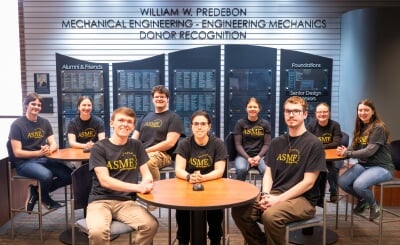
The team of student leaders determined ASME's mission would be threefold: connect with industry, connect with peers, and develop professionally.
"When we were restructuring our goals that summer and understanding how we make intentional efforts to impact the Department of Mechanical and Aerospace Engineering, we determined the mission was that ASME strives to connect mechanical engineering students with industry and help develop skills and relationships with peers to make mechanical engineering students more successful in life after Tech," said Bruesch.
The relationship development aspect of the organization's mission was paramount for Bruesch. He wants Huskies in the discipline to carry the camaraderie and collegiality forward on campus and in years to come.
"We're 1,500 students in our department, but how do we get people to say hi in the hallway? This club gets students to shake some hands, meet some peers, and ultimately become more well-rounded engineers," he said.
ASME's executive board members are making good on their promise to fulfill the organization's mission. During Tech's 2024-25 academic year, ASME hosted an internship panel, welcomed speakers from FM Insurance and Kenworth Trucks, held social events with other engineering student organizations on campus, and took a trip to tour the facilities at Enstrom Helicopter and Marinette Marine.
"As a mechanical engineer, I've been very impacted by the team-building and interpersonal skills I have developed. These opportunities helped me feel more comfortable in what I do on campus and with others. I hope that ASME at Michigan Tech can help bridge that gap for others."
For Bruesch, the growth and outreach was made possible with a vision of success and the determination to accomplish it.
Building Bridges with Industry
During summer 2024, while the ASME executive board was building a framework to revitalize the organization, Bruesch was also working as an intern for Enstrom Helicopter Corporation, a helicopter manufacturing company headquartered in Menominee, Michigan. There, he worked with engine buildup subassemblies, developed an in-flight monitoring software, and devised quality control processes.
"I loved my time at Enstrom and I wanted other students to experience that," said Bruesch. "I was the only intern, and I thought, 'I shouldn't be the only intern at a cool place like this making helicopters.' That was the moment I realized that I needed to bring along more Michigan Tech students."
Bruesch made the connections.
"I spoke with the HR manager and my manager in the engineering department and asked, 'How can I bring Tech students here? Is that something Enstrom would be interested in?' and it was an immediate yes," he said. "They liked the work I was doing for them and they liked my passion for ASME. We put a date on the books and started planning."
Bruesch and the rest of the ASME executive board started planning the trip for March 2025.
"The goal of this company tour was beyond just our experience as students," said Bruesch. "It was about building the processes to make these experiences easier for students in the future."
With Bruesch at the helm, the networking for the Husky road trip expanded. Enstrom Helicopter was a three-hour drive from Tech. Fincantieri Marinette Marine, a naval shipbuilding company, was just across the river from Enstrom in Marinette, Wisconsin.
"They were just one phone call away," Bruesch said. "I just called the front desk and introduced myself and ASME." It was as simple as that to round out ASME's company tour trip."
The endeavor to put Michigan Tech engineers front and center didn't stop there. For the trip, ASME took two vans from Husky Motors — but Bruesch didn't want just any vans.
"I had a vision for this photo. My vision was this photo of the Michigan Tech-branded Husky van next to the Enstrom helicopter, with all the students lined up in front," Bruesch said.
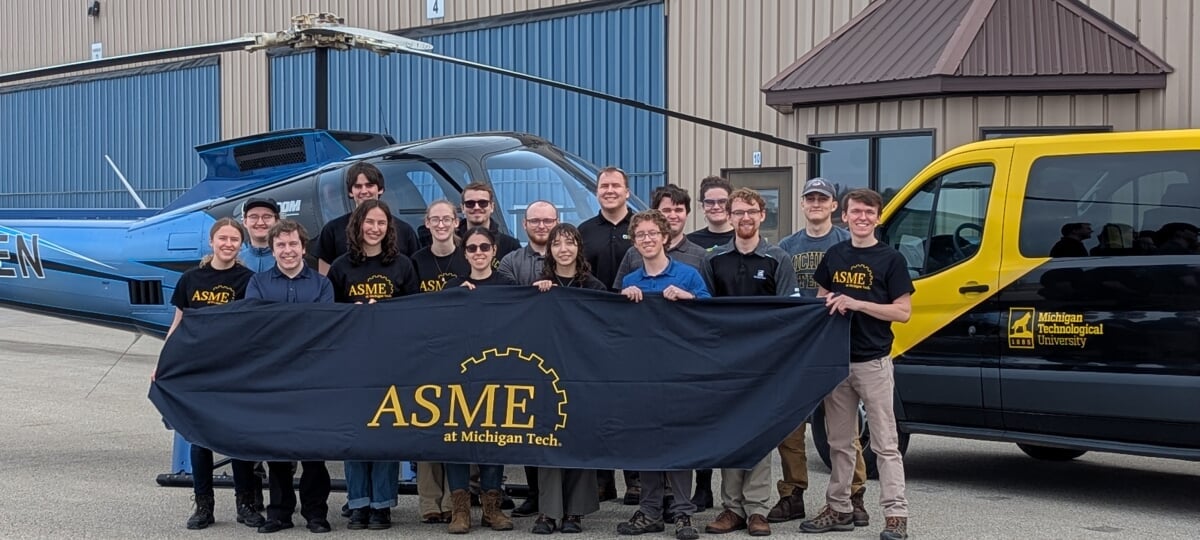
The power of picking up the phone came into play again. Bruesch called Husky Motors to share the concept.
"I explained it to Mitch from Husky Motors and asked if we could reserve specifically the vinyl-wrapped black and gold van," Bruesch said. "He chuckled and told me he could make that happen for me. Then I called Enstrom and explained my vision to them. I said, 'I want this photo,' and they said, 'So do we!'"
Mechanical Engineers on the Road
On March 18, 16 mechanical engineering students from ASME embarked on the trip. Their first stop was Enstrom Helicopter, where they met with the senior vice president of engineering and an experimental pilot, then toured the facilities. They saw where materials come in as raw stock and where they are machined, and watched the unit subassembly process and the final assembly into a flight-worthy helicopter model.
"We all got to see how a helicopter is built, from the ground up," said Bruesch. "That process of taking something from design to implementation, we got to see that in real time. That application of seeing what we were discussing in our classes was really impactful."
After lunch, the Huskies crossed the river into Wisconsin to visit Marinette Marine. There, they received their briefing, which consisted of a presentation covering the 2,000-page book of requirements Marinette Marine receives from the federal government and how the company's engineers turn that list of requirements into an actual naval ship. That process directly translates to the mechanical engineering course of study at Tech.
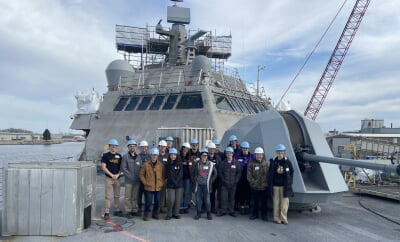
"They explained how they take those requirements, like we do our mechanical engineering practice courses, and then they make schematics," said Bruesch. "Then, it's the engineer's job to take it from schematic to design, to actually 3D model this ship. For those of our students in our mechanical engineering practice courses, this is exactly what we are doing in our coursework. And for those that hadn't taken that course yet, they can now draw on this experience."
"We got to see a ship that had already been launched, and it was eye-opening to see how the ship started as a 2,000-page book of requirements to become the actual ship," said Bruesch.
Turning theoretical coursework into a tangible experience for mechanical engineering students was a primary goal for the ASME trip. It also demonstrated to Bruesch that trips like these are as important as he had imagined.
Husky Pride Runs Deep
Bruesch's commitment to his mechanical engineering community comes from a love of Michigan Tech's community as a whole. Fueled by an affection for LEGOs and all things airplanes, becoming a mechanical engineer was his plan from early on. Originally from Traverse City, Michigan, a state aviation industry hub, Bruesch participated in an early college program through his high school and Northwestern Michigan College, which has a matriculation agreement with Michigan Tech.
But more than just the transfer credits brought Bruesch farther north.
"There were alumni from my robotics team that would visit, and they would tell me about the wonderful times they were having at Tech and how much they loved it," said Bruesch.
Given Michigan Tech's reputation of producing skilled engineers, Bruesch felt that MTU would be the right fit for him and his success. And, to him, the famed wintry conditions were an asset.
"I knew I wanted to go to a university with like-minded people who could withstand the cold," said Bruesch. "I knew with that cold and snow there would be that sense that we were all in this together. No matter how bad the windchill is, you've got your friends around you."
As a Michigan Tech student, he's discovered how the Husky sense of community extends beyond campus.
"I've had three internships, and at each one I've been welcomed with open arms from Michigan Tech alumni," said Bruesch. "There's such a culture and camaraderie between all of us who have braved the cold at Michigan Tech. I knew that going in, and I liked that a lot."
"It's not just about the schooling and classes, but it's about the toughness and the grit — call it tenacity if you want — of Tech students that led me here."
That same tenacity is pushing Bruesch forward. This summer, he interned with Cirrus Aircraft in their experimental division. He'll graduate with his bachelor's degree in mechanical engineering next spring and then stay at Tech to complete his master's degree in mechanical engineering as part of Michigan Tech's Accelerated Master's Program.
Bruesch hopes to one day work at the intersection of business and engineering in the experimental aerospace industry.
"So long as I can see the airplanes fly from the factory, I want to work on the airplanes people don't know about yet," said Bruesch. "My dream job is that fluid state between designing and working with customers."
Bruesch's time as a leader on campus isn't over yet, but he's looking forward to passing the baton.
"Getting to see these students grow under their own leadership and collaboration is very exciting for me," said Bruesch. "I'm not going to be ASME president forever. I'm not going to be on campus forever. I want this organization to have opportunities that last longer than my time at Tech."
Michigan Technological University is an R1 public research university founded in 1885 in Houghton, and is home to nearly 7,500 students from more than 60 countries around the world. Consistently ranked among the best universities in the country for return on investment, Michigan's flagship technological university offers more than 185 undergraduate and graduate degree programs in science and technology, engineering, computing, forestry, business, health professions, humanities, mathematics, social sciences, and the arts. The rural campus is situated just miles from Lake Superior in Michigan's Upper Peninsula, offering year-round opportunities for outdoor adventure.
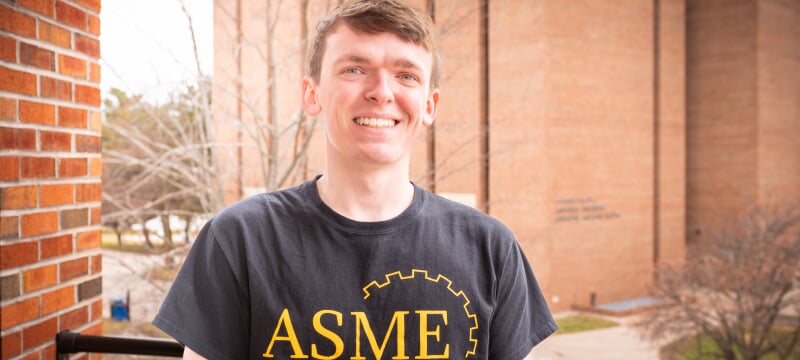
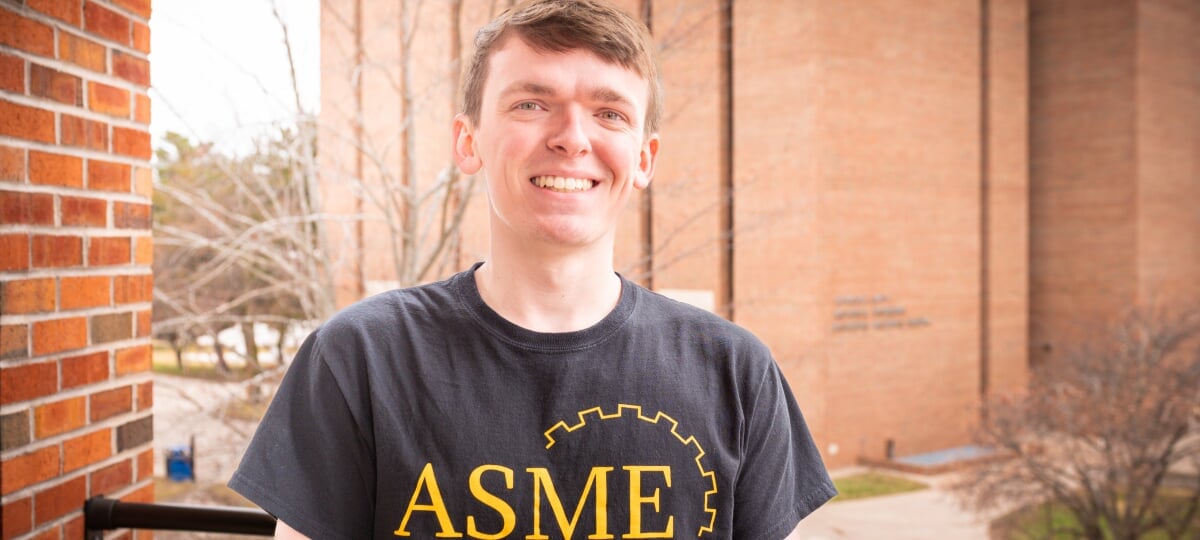




Comments